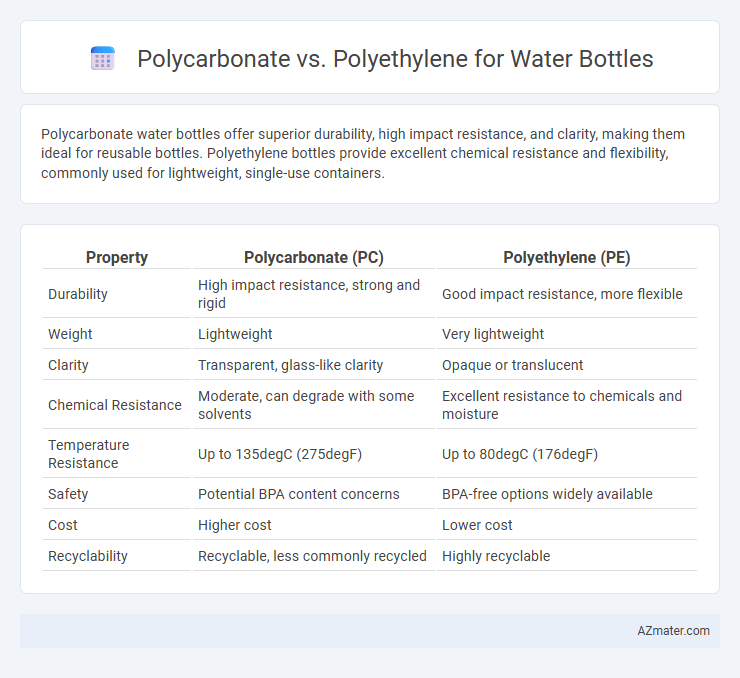Polycarbonate water bottles offer superior durability, high impact resistance, and clarity, making them ideal for reusable bottles. Polyethylene bottles provide excellent chemical resistance and flexibility, commonly used for lightweight, single-use containers.
Table of Comparison
| Property | Polycarbonate (PC) | Polyethylene (PE) |
|---|---|---|
| Durability | High impact resistance, strong and rigid | Good impact resistance, more flexible |
| Weight | Lightweight | Very lightweight |
| Clarity | Transparent, glass-like clarity | Opaque or translucent |
| Chemical Resistance | Moderate, can degrade with some solvents | Excellent resistance to chemicals and moisture |
| Temperature Resistance | Up to 135degC (275degF) | Up to 80degC (176degF) |
| Safety | Potential BPA content concerns | BPA-free options widely available |
| Cost | Higher cost | Lower cost |
| Recyclability | Recyclable, less commonly recycled | Highly recyclable |
Introduction to Polycarbonate and Polyethylene
Polycarbonate is a durable, impact-resistant thermoplastic known for its high clarity and strength, making it a popular choice for reusable water bottles. Polyethylene, a lightweight and flexible polymer, provides excellent chemical resistance and is commonly used in single-use and flexible water containers. Both materials offer distinct advantages depending on the intended use, with polycarbonate excelling in rigidity and longevity, while polyethylene emphasizes cost-effectiveness and safety for food contact.
Material Composition and Properties
Polycarbonate water bottles are made from BPA-free thermoplastic polymers known for high impact resistance, transparency, and rigidity, allowing for durable and clear containers. Polyethylene bottles consist primarily of long-chain hydrocarbons in thermoplastic form, providing excellent chemical resistance, flexibility, and lightweight properties but with less clarity and lower impact strength compared to polycarbonate. Material composition differences significantly influence properties such as durability, transparency, and flexibility, making polycarbonate preferable for heavy-duty use and polyethylene ideal for lightweight, chemical-safe applications.
Durability and Strength Comparison
Polycarbonate water bottles exhibit superior durability and impact resistance, making them less prone to cracking or breaking compared to polyethylene variants. Polyethylene, while lightweight and flexible, generally offers lower tensile strength and can degrade faster under repeated stress or exposure to UV light. Selecting polycarbonate ensures a longer-lasting, more robust water bottle ideal for rigorous use and outdoor activities.
Chemical Resistance and Safety
Polycarbonate offers moderate chemical resistance but can degrade when exposed to strong acids or alkalis, potentially leaching bisphenol A (BPA), raising safety concerns. Polyethylene, particularly high-density polyethylene (HDPE), exhibits excellent chemical resistance to acids, bases, and solvents, making it a safer option for water bottles without BPA leaching risks. For consumers prioritizing chemical safety and resistance, polyethylene is often preferred due to its stable and inert nature in contact with various liquids.
Weight and Portability
Polycarbonate water bottles are significantly lighter than polyethylene bottles, making them more convenient for portability during outdoor activities and travel. The higher strength-to-weight ratio of polycarbonate ensures durability without adding bulk, enhancing ease of carrying. Polyethylene bottles, while more affordable, tend to be heavier and less suited for situations where minimizing weight is a priority.
Impact on Water Taste and Odor
Polycarbonate water bottles tend to be favored for their durability but may sometimes impart a slight plastic taste or odor, especially when exposed to heat or prolonged use. Polyethylene, particularly high-density polyethylene (HDPE), is known for its inert properties and typically does not affect water taste or odor, making it a preferred choice for taste-sensitive consumers. Both materials are BPA-free versions to consider, but polyethylene's chemical stability often results in a cleaner drinking experience.
Environmental Impact and Recyclability
Polycarbonate water bottles, made from BPA-containing plastics, pose environmental concerns due to potential chemical leaching and limited recyclability in standard municipal programs, often downcycled rather than fully recycled. Polyethylene bottles, especially high-density polyethylene (HDPE), offer better environmental performance with higher recycling rates and widespread compatibility in curbside recycling systems, leading to more effective material recovery and reuse. Selecting polyethylene over polycarbonate minimizes ecological footprint by reducing hazardous waste and enhancing circular economy benefits within plastic bottle usage.
Cost and Availability
Polyethylene water bottles are generally more affordable and widely available due to their extensive use in consumer packaging and ease of production. Polycarbonate bottles tend to be more expensive because of their higher durability and clarity, often utilized in long-term reusable bottles. Availability of polyethylene makes it the preferred choice for single-use bottles, whereas polycarbonate is favored in premium, reusable markets.
Common Applications in Water Bottles
Polycarbonate water bottles are favored for their durability, clarity, and resistance to impact, making them ideal for reusable and high-performance bottles often used in sports and outdoor activities. Polyethylene bottles, particularly high-density polyethylene (HDPE), are widely used in disposable and lightweight water containers due to their chemical resistance, flexibility, and cost-effectiveness. Both materials meet safety standards for potable water storage, but polycarbonate provides better transparency, while polyethylene offers superior chemical resistance and recyclability.
Choosing the Best Material for Your Needs
Polycarbonate water bottles offer high durability, impact resistance, and clarity, making them ideal for users seeking a long-lasting and transparent option. Polyethylene bottles provide excellent chemical resistance and flexibility while being lightweight and cost-effective, suitable for daily hydration needs and outdoor activities. Assess factors like safety standards, weight preference, and environmental impact to determine the best material for your specific water bottle requirements.

Infographic: Polycarbonate vs Polyethylene for Water bottle
 azmater.com
azmater.com